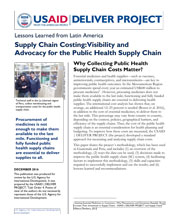Essential medicines and health supplies—such as vaccines, antiretrovirals, contraceptives, and micronutrients—are key to improving public health outcomes. In the Mesoamerican Region, governments spend an estimated US$600 million to procure medicines every year. However, procuring medicines does not make them available to the last mile; functioning and fully funded public health supply chains are essential to delivering health supplies. The international cost analysis has shown that, on average, an additional 12–25 percent is needed (Rosen et al. 2016), in addition to the cost of essential medicines, to deliver them to the last mile. This percentage may vary from country to country, depending on the context, policies, geographical barriers, and efficiency of the supply chains. Thus, the cost of the public health supply chain is an essential consideration for health planning and budgeting. To improve how these costs are measured, JSI's USAID | DELIVER PROJECT (the project) developed a standard approach for measuring and analyzing supply chain costs.
This paper shares the project's methodology, which has been used in Guatemala and Peru, and includes (1) an overview of the methodology, (2) ways the data can be used, (3) decisions made to improve the public health supply chain system, (4) facilitating factors to implement this methodology, (5) skills and capacities required to successfully implement and use the results, and (6) lessons learned and recommendations. JSI / USAID | DELIVER PROJECT, 2016.


